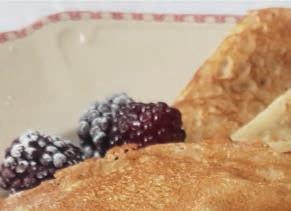
3 minute read
Pancakes with egg liqueur
from PoultryNL
The Netherlands
In the Dutch Antilles, crushed avocados are mixed with alcohol to make a yellow drink. Mariners brought this drink to The Netherlands, where eggs were substituted for avocados, due to an absence of the latter and because they had the same colour.
Advertisement
20 minutes
INGREDIENTS (for 8-10 pancakes)
2 eggs 500 ml full cream milk Pinch of salt 150 g of fl our Unsalted butter for frying 200 g blackberries Icing sugar Egg liqueur
Preparation:
1. Mix the eggs, milk, salt and fl our into a light, airy batter.
2. Melt the butter in a frying pan, pour enough batter into the pan to cover the base.
3. Fry the bottom side until it is golden brown and the upper side is dry, then turn it over.
4. Warm the blackberries with a little bit of water.
5. Fill the pancakes with the egg liqueur, serve with the blackberries and icing sugar.
Enjoy!
For more egg recipes: www.mmmeggies.nl




With blackberries




Piet Van der Aar

Nutritionists: prepare for the future!
Piet van der Aar is former Director of Schothorst Feed Research H igh feedstuff prices, the public debate about feed versus food, the search for alternative protein sources, and above all global warming are forcing the poultry sector to take a different approach to feed. Circularity and innovation should be the basis for a transition in poultry feeds.
The enormous genetic improvements, improved feed, and good hygiene have resulted in low feed conversion rates in broilers and high egg production in layers. The pride of the sector provoked a counter-reaction from opinion leaders from well-to-do urbanised society, who oppose this mode of food production. They demand slow-growing broilers and free-range layers. Retailers acted on these demands and offer a wide range of eggs and meat from slow-growing chickens. The resulting larger carbon footprint, less feed efficiency, and higher risk of avian influenza do not seem to play a role. It is the task of nutritionists to reduce these negative effects.
Most poultry feeds for this type of production still consist of corn and soya. The consumer trends call for a mindset change among nutritionists. The lower protein/ energy ratios in the diet allow for the use of less digestible feedstuffs in the feed. It is an opportunity to formulate more circular diets and use locally available ingredients. Research and innovation will be needed to optimise the use of new feedstuffs. Not only their maximum incorporation in feeds should be determined but also methods to improve the digestibility of these potentially suitable products. A wide variety of treatments are available. Chemical treatment, solid-state fermentation, mechanical processing, or specialised enzyme addition are potential techniques.
Insect protein is often mentioned, but has limited potential. Insects convert plant protein into better digestible proteins, but each bioconversion comes with losses. Recent experiments by Wageningen University showed that black soldier fly maggots’ N conversion rate is 38%. This is comparable with dairy cows. But also 24% of the carbon was converted into CO₂.
The current challenges for nutritionists cannot be solved without substantial investment in research and innovation. Without this, the transition towards more sustainable poultry feed will be impossible.










